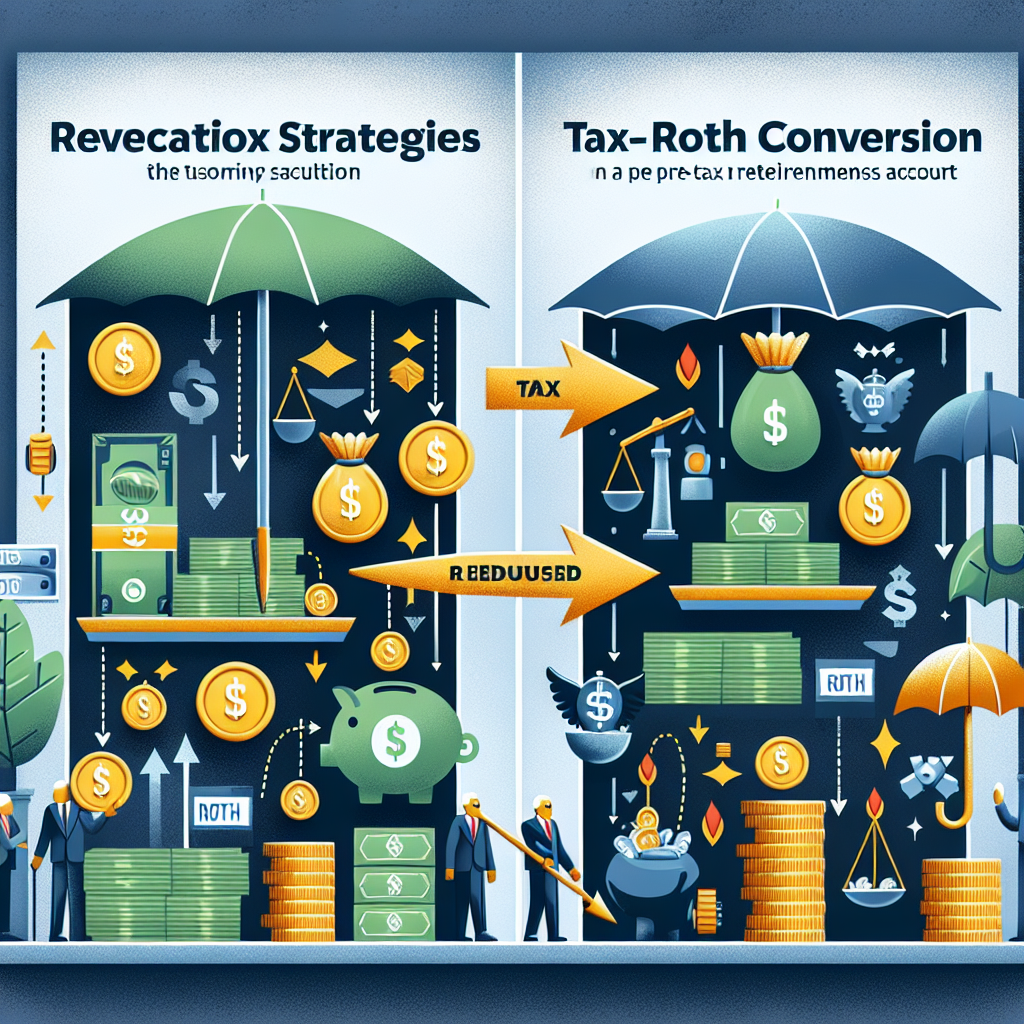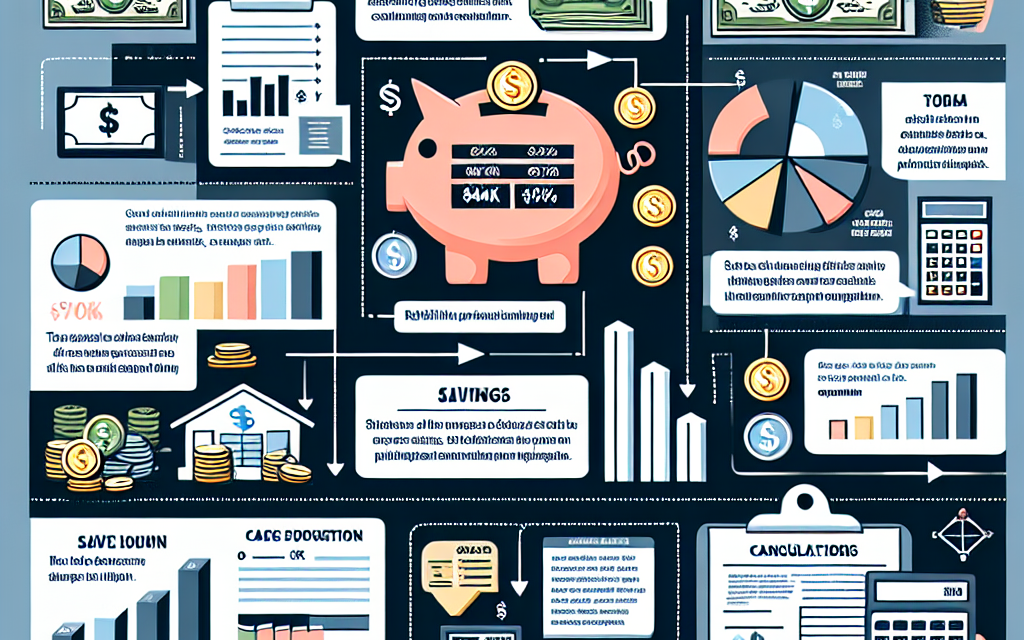“Maximize Savings: Smart Strategies for Minimizing Taxes on Your $845k Roth Conversion”
Introduction
Converting a traditional IRA to a Roth IRA can be a strategic move for long-term tax planning, especially when dealing with a substantial amount like $845,000. However, this conversion triggers a taxable event, as the converted amount is added to your taxable income for the year. To mitigate the tax impact, it’s crucial to employ effective strategies. These strategies may include spreading the conversion over multiple years to avoid pushing yourself into a higher tax bracket, utilizing available deductions and credits to offset the increased income, and considering the timing of the conversion to align with years of lower income. Additionally, charitable contributions and other tax-efficient investment strategies can further reduce the tax burden. By carefully planning and implementing these strategies, individuals can optimize their Roth conversion process, minimizing immediate tax liabilities while maximizing the long-term benefits of tax-free growth and withdrawals in retirement.
Understanding Roth Conversion Timing: Maximize Tax Efficiency
When considering a Roth conversion, particularly one as substantial as $845,000, understanding the timing and strategies to maximize tax efficiency is crucial. A Roth conversion involves transferring funds from a traditional IRA or 401(k) into a Roth IRA, thereby allowing future withdrawals to be tax-free. However, the conversion itself is a taxable event, and the amount converted is added to your taxable income for the year. Therefore, strategic planning is essential to minimize the tax burden.
One of the primary strategies to consider is spreading the conversion over multiple years. By doing so, you can potentially avoid being pushed into a higher tax bracket. For instance, if you were to convert the entire $845,000 in a single year, it could significantly increase your taxable income, possibly subjecting you to the highest marginal tax rates. Instead, converting smaller portions annually can help manage the tax impact more effectively. This approach requires careful analysis of your current and projected income, as well as an understanding of the tax brackets.
Another important consideration is the timing of the conversion within the tax year. Converting earlier in the year can provide more time for the converted funds to grow tax-free within the Roth IRA. However, it is also essential to consider your overall financial situation and any potential changes in income that could affect your tax bracket. For example, if you anticipate a lower income year due to retirement or other factors, it might be advantageous to plan the conversion for that year to take advantage of a lower tax rate.
Additionally, it is beneficial to evaluate any available deductions or credits that could offset the increased taxable income resulting from the conversion. Charitable contributions, for instance, can be a strategic tool in this regard. By making significant charitable donations in the same year as the conversion, you can reduce your taxable income, thereby mitigating some of the tax impact. It is advisable to consult with a tax professional to explore all available options and ensure compliance with IRS regulations.
Furthermore, understanding the implications of state taxes is also vital. Some states do not tax Roth conversions, while others do. If you reside in a state with high income tax rates, it might be worth considering a move to a state with more favorable tax treatment before executing the conversion. This decision, however, should not be taken lightly and requires a comprehensive evaluation of all factors involved, including lifestyle and cost of living.
Lastly, it is important to consider the impact of the conversion on other aspects of your financial plan, such as Medicare premiums and Social Security benefits. A significant increase in taxable income could lead to higher Medicare premiums or affect the taxation of Social Security benefits. Therefore, a holistic approach that considers all elements of your financial situation is essential.
In conclusion, executing an $845,000 Roth conversion requires careful planning and strategic timing to maximize tax efficiency. By spreading the conversion over multiple years, considering the timing within the tax year, leveraging deductions and credits, evaluating state tax implications, and understanding the broader financial impact, you can effectively manage the tax burden and enhance your long-term financial security. Consulting with financial and tax professionals can provide valuable insights and ensure that your strategy aligns with your overall financial goals.
Utilizing Tax Brackets: Strategic Conversion Amounts
When considering a Roth conversion, particularly one as substantial as $845,000, it is crucial to employ strategies that minimize the tax burden. One effective approach is to utilize tax brackets strategically, ensuring that the conversion amount is optimized to take advantage of lower tax rates. By carefully planning the conversion, individuals can potentially reduce their overall tax liability, thereby preserving more of their retirement savings.
To begin with, understanding the current tax brackets is essential. The U.S. tax system is progressive, meaning that income is taxed at increasing rates as it rises through different brackets. Therefore, converting the entire $845,000 in a single year could push an individual into a higher tax bracket, resulting in a significant tax bill. Instead, spreading the conversion over multiple years can help manage the tax impact by keeping the taxable income within lower brackets.
For instance, if an individual is currently in the 24% tax bracket, converting an amount that keeps them within this bracket can be advantageous. This strategy involves calculating how much room is available within the current bracket before reaching the next one. By converting only that amount, the individual can avoid crossing into a higher tax bracket, thereby minimizing the tax rate applied to the conversion.
Moreover, it is important to consider the impact of other income sources. Since Roth conversions are treated as ordinary income, they are added to any other income the individual receives during the year. This includes wages, dividends, and other retirement distributions. Therefore, a comprehensive review of all income sources is necessary to determine the optimal conversion amount. By doing so, individuals can ensure that their total income remains within a desired tax bracket.
Additionally, timing plays a crucial role in strategic Roth conversions. For those who have recently retired or experienced a temporary reduction in income, there may be an opportunity to convert larger amounts at lower tax rates. During these years, when taxable income is lower, individuals can take advantage of the lower brackets to convert more of their traditional IRA or 401(k) funds to a Roth IRA. This approach not only reduces the immediate tax burden but also sets the stage for tax-free withdrawals in the future.
Furthermore, it is beneficial to consider the potential impact of future tax rate changes. While current tax rates are known, future rates are subject to change due to legislative adjustments. Therefore, individuals should remain informed about potential tax reforms that could affect their conversion strategy. By staying updated, they can make informed decisions about whether to accelerate or delay conversions based on anticipated changes in tax policy.
In conclusion, reducing taxes on an $845,000 Roth conversion requires a strategic approach that leverages tax brackets effectively. By spreading the conversion over multiple years, considering all income sources, and timing conversions during low-income periods, individuals can optimize their tax situation. Additionally, staying informed about potential tax rate changes ensures that the strategy remains adaptable to future circumstances. Through careful planning and execution, individuals can achieve a more favorable tax outcome, ultimately enhancing their financial security in retirement.
Charitable Contributions: Offset Tax Liabilities
When considering a Roth conversion, particularly one as substantial as $845,000, the potential tax liabilities can be daunting. However, strategic planning can significantly mitigate these liabilities, and one effective approach is through charitable contributions. By leveraging charitable giving, individuals can offset the taxes incurred from such a conversion, thereby optimizing their financial outcomes.
To begin with, understanding the mechanics of a Roth conversion is crucial. This process involves transferring funds from a traditional IRA or 401(k) into a Roth IRA, which, while beneficial in the long term due to tax-free withdrawals, triggers a taxable event in the year of conversion. The entire converted amount is added to your taxable income, potentially pushing you into a higher tax bracket. Therefore, it becomes imperative to explore strategies that can alleviate this immediate tax burden.
Charitable contributions emerge as a viable solution in this context. By donating to qualified charitable organizations, individuals can claim deductions that directly reduce their taxable income. This strategy not only supports philanthropic causes but also provides a financial advantage by lowering the effective tax rate on the conversion amount. For those who are charitably inclined, this dual benefit can be particularly appealing.
One effective method to maximize the tax benefits of charitable contributions is through a Donor-Advised Fund (DAF). A DAF allows individuals to make a charitable contribution, receive an immediate tax deduction, and then recommend grants from the fund over time. This flexibility is advantageous, as it enables donors to align their charitable giving with their personal values and financial goals. By contributing to a DAF in the same year as the Roth conversion, individuals can significantly reduce their taxable income, thereby offsetting the tax impact of the conversion.
Moreover, for those aged 70½ or older, a Qualified Charitable Distribution (QCD) offers another strategic avenue. A QCD allows individuals to transfer up to $100,000 annually from their IRA directly to a qualified charity, without the distribution being counted as taxable income. This approach not only satisfies the required minimum distribution (RMD) but also reduces the overall taxable income, which can be particularly beneficial in the year of a Roth conversion.
In addition to these strategies, it is essential to consider the timing and amount of charitable contributions. By carefully planning the timing of donations, individuals can optimize their tax situation. For instance, bunching charitable contributions into a single tax year can maximize deductions, especially if the standard deduction is typically more beneficial in other years. This approach requires foresight and planning but can result in substantial tax savings.
Furthermore, consulting with a tax professional or financial advisor is highly recommended when navigating the complexities of a large Roth conversion and associated charitable contributions. These experts can provide personalized advice, ensuring that the strategies employed align with both current tax laws and individual financial circumstances.
In conclusion, while an $845,000 Roth conversion presents significant tax challenges, strategic charitable contributions offer a powerful tool for offsetting these liabilities. By utilizing vehicles such as Donor-Advised Funds and Qualified Charitable Distributions, and by carefully planning the timing and amount of donations, individuals can effectively reduce their taxable income. This not only alleviates the immediate tax burden but also supports meaningful charitable endeavors, creating a win-win scenario for both the donor and the recipient organizations.
Tax-Loss Harvesting: Minimize Tax Impact

When considering a Roth conversion, particularly one as substantial as $845,000, it is crucial to employ strategies that minimize the tax impact. One effective approach is tax-loss harvesting, a method that can significantly offset the taxes incurred during the conversion process. By strategically selling investments at a loss, investors can counterbalance the capital gains and taxable income generated by the conversion, thereby reducing the overall tax liability.
To begin with, understanding the mechanics of tax-loss harvesting is essential. This strategy involves selling securities that have declined in value to realize a loss. These losses can then be used to offset capital gains from other investments, and if the losses exceed the gains, up to $3,000 can be deducted against ordinary income annually. Any remaining losses can be carried forward to future tax years, providing a long-term benefit. This approach is particularly advantageous during a Roth conversion, as it can help mitigate the increased taxable income resulting from the conversion amount.
Moreover, timing plays a critical role in maximizing the benefits of tax-loss harvesting. Investors should carefully assess their portfolios to identify underperforming assets that can be sold at a loss. It is advisable to conduct this assessment towards the end of the tax year, as this allows for a comprehensive evaluation of the year’s gains and losses. However, it is also important to remain vigilant throughout the year, as market fluctuations can present unexpected opportunities for harvesting losses.
In addition to timing, it is vital to be aware of the wash-sale rule, which prohibits repurchasing the same or substantially identical security within 30 days before or after the sale. Violating this rule would disallow the loss for tax purposes, negating the benefits of the strategy. To avoid this pitfall, investors can consider purchasing similar, but not identical, securities to maintain their desired market exposure while still realizing the tax benefits.
Furthermore, integrating tax-loss harvesting with other tax-efficient strategies can enhance its effectiveness. For instance, pairing it with charitable contributions can provide additional deductions, further reducing taxable income. Donating appreciated securities to charity not only avoids capital gains taxes but also allows for a deduction of the fair market value of the securities, thereby amplifying the tax-saving potential.
Additionally, consulting with a tax professional or financial advisor is highly recommended when executing a Roth conversion of this magnitude. These experts can provide personalized advice tailored to an individual’s financial situation, ensuring that all available strategies are utilized effectively. They can also assist in navigating the complexities of tax regulations, thereby minimizing the risk of errors that could lead to penalties or missed opportunities for savings.
In conclusion, while a Roth conversion of $845,000 presents a significant tax challenge, employing strategies such as tax-loss harvesting can substantially mitigate the impact. By carefully timing the sale of underperforming assets, adhering to the wash-sale rule, and integrating other tax-efficient strategies, investors can effectively reduce their tax liability. Engaging with financial professionals further enhances the likelihood of a successful conversion, ensuring that the long-term benefits of a Roth account are realized without undue tax burdens.
State Tax Considerations: Optimize Conversion Location
When considering a Roth conversion of $845,000, understanding state tax implications is crucial to optimizing the financial outcome. The decision of where to execute this conversion can significantly impact the overall tax liability, as state income tax rates vary widely across the United States. Therefore, it is essential to evaluate the tax environment of your current state of residence and consider the potential benefits of relocating to a more tax-friendly state before proceeding with the conversion.
To begin with, it is important to recognize that some states do not impose an income tax, which can be advantageous for individuals planning a substantial Roth conversion. States such as Florida, Texas, and Nevada offer a tax-free environment for income, including income generated from Roth conversions. By relocating to one of these states, individuals can potentially eliminate state income tax liability on the conversion amount, thereby maximizing the benefits of the Roth conversion.
However, moving to a tax-free state is not always feasible or desirable for everyone. In such cases, it is beneficial to explore states with lower income tax rates or those that offer specific tax exemptions for retirement income. For instance, states like Pennsylvania and Mississippi do not tax retirement income, including Roth conversions, for residents over a certain age. This can provide a significant tax advantage for retirees looking to convert their traditional IRA to a Roth IRA.
Moreover, some states offer partial exemptions or credits for retirement income, which can also be leveraged to reduce the tax burden. For example, Illinois exempts distributions from qualified retirement plans, including Roth conversions, from state income tax. Similarly, other states may offer credits or deductions that can offset the tax liability associated with a Roth conversion. It is advisable to consult with a tax professional to understand the specific tax benefits available in your state and how they can be applied to your situation.
In addition to considering the state tax environment, timing the conversion strategically can also play a role in minimizing taxes. Spreading the conversion over multiple years can help manage the tax impact by keeping the income within lower tax brackets. This approach can be particularly effective in states with progressive tax systems, where higher income levels are taxed at higher rates. By converting smaller amounts each year, individuals can potentially reduce the overall state tax liability associated with the conversion.
Furthermore, it is essential to consider the potential impact of state-specific tax laws on the conversion process. Some states may have unique rules regarding the taxation of Roth conversions, such as requiring the inclusion of the conversion amount in state taxable income even if it is not subject to federal tax. Understanding these nuances is critical to accurately estimating the state tax liability and planning accordingly.
In conclusion, optimizing the location for an $845,000 Roth conversion involves a thorough analysis of state tax considerations. By evaluating the tax environment of different states, considering relocation to tax-free or tax-friendly states, and strategically timing the conversion, individuals can effectively reduce their state tax liability. Consulting with a knowledgeable tax advisor can provide valuable insights and guidance tailored to your specific circumstances, ensuring that the Roth conversion is executed in the most tax-efficient manner possible.
Spousal Income Splitting: Reduce Tax Burden
When considering a Roth conversion, particularly one as substantial as $845,000, it is crucial to explore strategies that can mitigate the associated tax burden. One effective approach is spousal income splitting, which can significantly reduce the overall tax liability. This strategy involves distributing income between spouses in a manner that takes advantage of lower tax brackets, ultimately minimizing the taxes owed on the conversion.
To begin with, understanding the mechanics of a Roth conversion is essential. A Roth conversion involves transferring funds from a traditional IRA or 401(k) into a Roth IRA. While this move offers the benefit of tax-free withdrawals in retirement, it requires paying taxes on the converted amount in the year of the conversion. Given the substantial sum of $845,000, the tax implications can be considerable. Therefore, employing spousal income splitting can be a prudent measure to alleviate this financial burden.
Spousal income splitting leverages the progressive nature of the tax system, where higher income levels are taxed at higher rates. By distributing income between spouses, it is possible to utilize both partners’ lower tax brackets, thereby reducing the overall tax rate applied to the conversion. This strategy is particularly beneficial when one spouse earns significantly more than the other, as it allows for a more balanced income distribution and optimal use of available tax brackets.
To implement spousal income splitting effectively, it is important to consider the filing status of the couple. Married couples have the option to file jointly or separately, and each choice has distinct tax implications. Filing jointly often provides access to more favorable tax brackets and deductions, making it the preferred option for many couples. However, in certain situations, filing separately may offer advantages, particularly if one spouse has substantial deductions or if there are concerns about liability for the other spouse’s tax obligations.
Moreover, it is essential to evaluate the impact of spousal income splitting on other aspects of the couple’s financial situation. For instance, shifting income between spouses can affect eligibility for certain tax credits and deductions, such as the Child Tax Credit or the Earned Income Tax Credit. Therefore, a comprehensive analysis of the couple’s entire financial picture is necessary to ensure that the benefits of income splitting outweigh any potential drawbacks.
In addition to spousal income splitting, other strategies can complement this approach to further reduce the tax burden of a Roth conversion. For example, timing the conversion to coincide with a year of lower overall income can be advantageous. This might occur during a year of retirement, a sabbatical, or any period where income is temporarily reduced. Additionally, spreading the conversion over multiple years can help manage the tax impact by keeping the converted amount within lower tax brackets each year.
In conclusion, spousal income splitting is a valuable strategy for reducing the tax burden associated with an $845,000 Roth conversion. By strategically distributing income between spouses, it is possible to take advantage of lower tax brackets and minimize the overall tax liability. However, it is crucial to consider the broader financial implications and explore complementary strategies to ensure the most favorable outcome. Consulting with a tax professional can provide personalized guidance and help navigate the complexities of this approach, ultimately leading to a more efficient and effective Roth conversion process.
Qualified Charitable Distributions: Leverage for Tax Reduction
When considering a Roth conversion, particularly one as substantial as $845,000, the tax implications can be significant. However, there are strategies available to mitigate the tax burden, one of which involves leveraging Qualified Charitable Distributions (QCDs). This approach not only aids in reducing taxable income but also aligns with philanthropic goals, offering a dual benefit for those inclined towards charitable giving.
To begin with, it is essential to understand the mechanics of a Roth conversion. This process involves transferring funds from a traditional IRA to a Roth IRA, thereby incurring income taxes on the converted amount. The primary advantage of a Roth IRA is that it allows for tax-free withdrawals in retirement, but the upfront tax cost can be daunting. This is where QCDs come into play as a strategic tool.
Qualified Charitable Distributions allow individuals aged 70½ or older to donate up to $100,000 per year directly from their IRA to a qualified charity. The key benefit of a QCD is that it can be excluded from taxable income, which is particularly advantageous when managing the tax impact of a Roth conversion. By reducing the overall taxable income, QCDs can effectively lower the tax bracket, thereby decreasing the tax rate applied to the converted amount.
Moreover, integrating QCDs into a Roth conversion strategy requires careful planning. It is crucial to ensure that the charitable distribution is made directly from the IRA to the charity, as any funds withdrawn and then donated do not qualify for the tax exclusion. Additionally, the timing of the QCD is important; it should ideally be executed in the same tax year as the Roth conversion to maximize the tax benefits.
Furthermore, for individuals who are charitably inclined, QCDs offer an opportunity to fulfill philanthropic objectives while simultaneously managing tax liabilities. This approach not only supports charitable organizations but also enhances the individual’s financial strategy by optimizing tax efficiency. It is a win-win situation that aligns personal values with financial goals.
In addition to QCDs, it is worth considering other complementary strategies to further reduce the tax impact of a Roth conversion. For instance, spreading the conversion over multiple years can help manage the tax liability by preventing a significant spike in taxable income in a single year. Additionally, consulting with a tax advisor or financial planner can provide personalized insights and ensure compliance with IRS regulations.
In conclusion, while a Roth conversion of $845,000 presents a substantial tax challenge, leveraging Qualified Charitable Distributions offers a viable solution. By reducing taxable income through charitable giving, individuals can effectively lower their tax burden while supporting causes they care about. This strategy not only enhances tax efficiency but also aligns with broader financial and philanthropic objectives. As with any financial decision, careful planning and professional guidance are essential to maximize the benefits and ensure a successful outcome.
Q&A
1. **Question:** What is a Roth conversion, and why might someone consider it?
– **Answer:** A Roth conversion involves transferring funds from a traditional IRA or 401(k) into a Roth IRA. This can be beneficial as it allows for tax-free growth and withdrawals in retirement, potentially reducing future tax liabilities.
2. **Question:** How can timing affect the tax impact of a Roth conversion?
– **Answer:** Timing the conversion in a year with lower income can reduce the tax impact, as the conversion amount is added to taxable income. Converting in a year with lower income or during retirement before required minimum distributions (RMDs) begin can be advantageous.
3. **Question:** What role do tax brackets play in planning a Roth conversion?
– **Answer:** Understanding tax brackets is crucial, as converting too much in one year can push you into a higher tax bracket. Spreading the conversion over multiple years can help manage the tax rate applied to the conversion amount.
4. **Question:** How can charitable contributions offset the tax liability of a Roth conversion?
– **Answer:** Making charitable contributions can provide tax deductions that offset the taxable income from a Roth conversion. Donating appreciated assets or using a donor-advised fund can maximize this strategy.
5. **Question:** What is the impact of state taxes on a Roth conversion?
– **Answer:** State taxes can significantly affect the overall tax liability of a Roth conversion. Converting in a state with no income tax or planning a move to such a state before conversion can reduce the tax burden.
6. **Question:** How can tax-loss harvesting be used in conjunction with a Roth conversion?
– **Answer:** Tax-loss harvesting involves selling investments at a loss to offset capital gains and reduce taxable income. This strategy can help offset the additional income from a Roth conversion, lowering the overall tax liability.
7. **Question:** What is the “backdoor Roth IRA” strategy, and how does it relate to Roth conversions?
– **Answer:** The backdoor Roth IRA is a strategy for high-income earners who exceed Roth IRA contribution limits. It involves making nondeductible contributions to a traditional IRA and then converting those funds to a Roth IRA, allowing for tax-free growth without direct contributions.
Conclusion
Strategies for reducing taxes on an $845k Roth conversion include spreading the conversion over multiple years to avoid higher tax brackets, utilizing tax deductions and credits to offset the taxable income, and timing the conversion in a year with lower overall income. Additionally, charitable contributions can be used to reduce taxable income, and if applicable, coordinating with other tax-advantaged accounts or losses can further mitigate tax liabilities. Consulting with a tax professional to tailor these strategies to individual circumstances is advisable to optimize tax outcomes.





